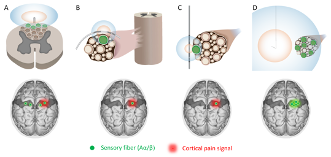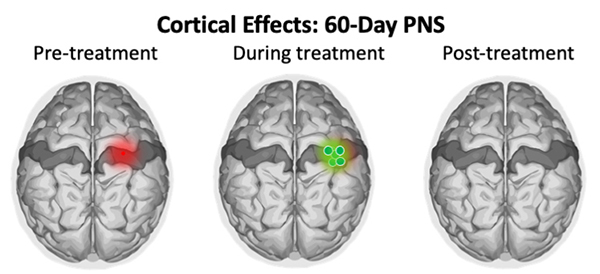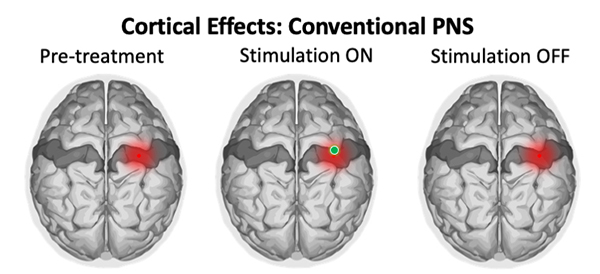Authors: Chief Scientific Officer Josh Boggs, PhD; Senior Research Manager, Nate Crosby

In a recently published review, a novel pain mechanism theory was proposed that indicates short-term percutaneous PNS may lead to sustained pain relief by reconditioning the CNS, potentially obviating the need for permanently implanted systems.
Drs. Timothy Deer, Sam Eldabe, Steven Falowski, Marc Huntoon, Peter Staats, Nathan Crosby, and Isaac Cassar and I proposed potential mechanisms by which PNS may provide sustained pain relief by reconditioning the CNS. This review was conducted to explore the potential theories and mechanisms by which percutaneous PNS may produce the sustained pain relief that is being reported in multiple clinical studies. An additional goal was to generate discussion in the clinical and scientific communities that may lead to studies that further explore the possibility of modulating a centrally-maintained pain state by providing peripheral input through PNS. Below we dive more specifically into the findings of this research related to the cortical effects of short-term PNS and conventional PNS.
PNS with Remote Selective Targeting Can Produce Sustained Relief
Remote selective targeting is an approach to PNS that is made possible through multiple factors, including open-coiled leads with a long monopolar electrode, waveform design, and use of a system that enables lead placement remote from the nerve (e.g., 0.5-3 cm), that collectively enable more selective, preferential activation of targeted non-pain sensory fibers.
The collective review of numerous publications by Deer et al. found that remote selective targeting has a greater potential to produce beneficial reconditioning of maladaptive CNS changes compared to conventional stimulation strategies, ultimately helping patients avoid the need for a permanently implanted PNS system.
60-day PNS with remote selective targeting produces focal and robust signals that may enable sustained relief without permanent implantation
Remote selective targeting PNS enables selective activation of target sensory fibers and produces more focal and robust signals from the periphery to the CNS. As shown in the figure below representing the proposed cortical effects of remote selective targeting, the red region in the cortex (left) represents an area of maladaptive plasticity contributing to chronic pain. During treatment, pain-reducing signals are produced that are robust (i.e., are produced by selectively activating a large number of target sensory fibers) and are focal to the region of pain. These signals (middle; represented in green) result in reconditioning of the cortex during the 60-day treatment such that the maladaptive plasticity is no longer present and pain relief is maintained post-treatment (right).

- The red region in the cortex represents an area contributing to chronic pain (left)
- During treatment the cortex receives focal and robust non-nociceptive signals (green, middle) generated by remote selective targeting PNS for 60 days
- Continuous stimulation is not required to support pain relief
- Remote selective targeting PNS produces focal and robust non-nociceptive signals
- Sustained pain relief without permanent implantation may be enabled (right)
Whereas remote selective targeting PNS produces focal and robust signals, conventional PNS is often limited
In comparing the techniques of conventional PNS with remote selective targeting PNS, the review by Deer et al. found that conventional PNS is not designed to meet the required conditions to effectively recondition the CNS and therefore typically requires continuous stimulation from implanted devices to support long-term pain relief.
Conventional PNS requires continuous stimulation for sustained pain relief
In the graphic below, the red highlighted portion again represents maladaptive cortical plasticity that contributes to chronic pain (left). When conventional PNS is active, the target sensory fibers can produce comfortable pain-relieving sensations (middle; shown in green). While these signals are focal in the region of pain, they are not robust enough to recondition the CNS and so the maladaptive CNS changes associated with chronic pain remain when stimulation ends (right), and pain relief is short-lived in the absence of continuous stimulation. Additionally, with conventional PNS, the review also noted that increasing stimulation intensity in an attempt to produce more robust signals often produces unintended discomfort (e.g., motor or pain fiber activation).

- Continuous stimulation is required to support pain relief with conventional PNS
- Conventional PNS-generated signals are insufficient to recondition the CNS, allowing pain to return when stimulation is turned off
- To support sustained pain relief with conventional PNS, a permanently implanted system is typically necessary
Conclusion: PNS with Remote Selective Targeting May Enable Reconditioning of the Cortex Necessary to Produce Sustained Chronic Pain Relief
Based on the review of the techniques, technology, and peripheral and cortical effects of both conventional and remote selective targeting PNS approaches, we concluded with the following theory: remote selective targeting may enable sustained pain relief without a permanent PNS system implant by reconditioning the CNS during a short-term (e.g., 60-day) treatment.
In closing, based on our review we see the potential of percutaneous PNS to offer patients a non-permanent treatment option with sustainable pain relief results.
Study authors: Timothy Deer, MD, Sam Eldabe, MD, Steven Falowski, MD, Marc Huntoon, MD, Peter Staats, MD, Isaac Cassar, Nathan Crosby, PhD, and Joseph Boggs, PhD

 Researchers Unveil a New Theory Explaining Long-term Pain Relief
Researchers Unveil a New Theory Explaining Long-term Pain Relief

Leave a Reply